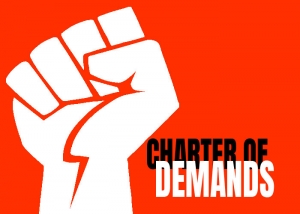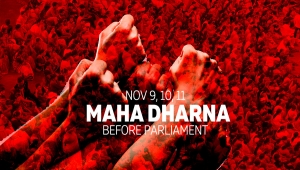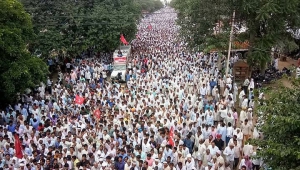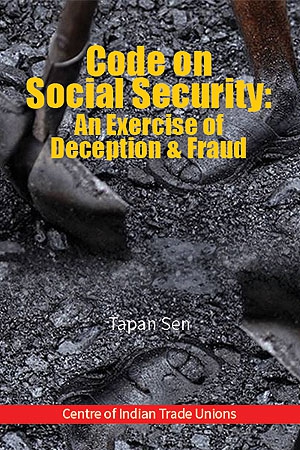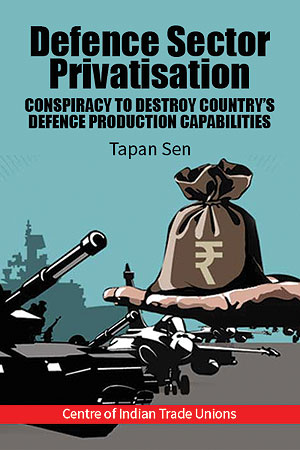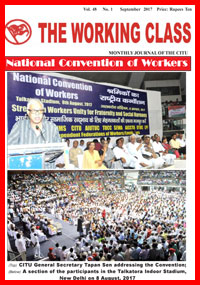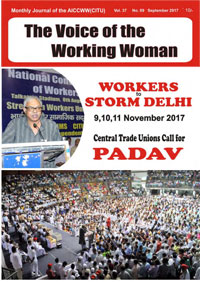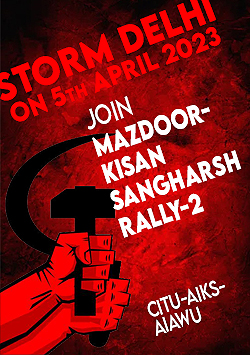Super User
Contain price rise of essential commodities!
Contain price rise of essential commodities! Strengthen public distribution system!
The prices of essential commodities, food, medicines, house rents, health, education, transport –most essential for the people in their day to day lives – have been continuously going up. But the wages for most of the workers, particularly in the unorganised sector, continue to remain the same. How do we survive?
This is not just the demand of the workers. It is the demand of all sections of working people – peasants, agricultural workers, artisans, employees – almost everybody, except of course, of those who benefit from this rise in prises.
Why are food prices rising?
Are the peasants who produce our food getting higher prices? Are they getting richer? Are they experiencing ‘Acche Din’?
NO. The cost of inputs for agriculture, fertilisers, pesticides, seeds etc have gone up. But the peasants are not getting remunerative prices. In many places they are burning their crops, throwing them on highways or distributing free to the people as mark of protest because they do not even get the cost of transport to take them to the markets.
Most of the peasants do not get cheap institutional credit. They are compelled to borrow from private money lenders at high interests. Unable to repay their debts many farmers are committing suicide. In the last twenty years, around 3 lakh farmers have committed suicide. Agriculture continues to be in crisis.
Then who is benefiting from the rise in food prices? Where is our money going? – Into the pockets of big traders and big business. With the benign blessings of the government - the government policies are so formulated to benefit the big business. The government is dismantling the public distribution system on the one hand. On the other, it is patronising corporate traders engaged in hoarding and speculation in commodity market, particularly in food and related commodities. It is these speculators who are becoming richer and richer while the working poor are forced to go hungry.
In addition, the drastic curtailment of subsidies on fuel and fertilisers, deregulation of electricity tariff and various other public utility services is creating a cascading effect on the already rising prices. The price of crude oil in international market has drastically come down by half in the last three years. But the government refuses to pass on this benefit to the people by reducing the prices of diesel and petrol.
The government has many tricks under its sleeve to dismantle the public distribution system. Large numbers of people have already been pushed out of its purview through a ridiculous poverty line. The Food Security Act is yet to be implemented in most parts of the country. The government has decided upon cash transfers to bank accounts linked to Aadhar. It has decided to allow FDI in multi brand retail trade on the deceptive pretext that this would bring down prices and provide better returns to the farmers, even when worldwide experience proves otherwise.
The working people - working in the factories or mines, in the offices, schools or colleges or in the hospitals or in the fields - are being made sacrificial lambs to increase the profits of the traders’ lobby, both domestic and foreign.
Today, the policies of the government that are deliberately designed to result in price rise to benefit the big traders, middlemen and big business. That is the reason for price rise causing misery to ordinary people.
What do we want?
The trade unions have demanded the following concrete measures to curtail price rise:
• Strengthen and universalise the public distribution system
• Ban speculation and futures trading in essential commodities
But the government is totally deaf to this just demand.
That is why the central trade unions and almost all industrial federations have called the 3 days’ massive relay dharna on 9-11 November 2017 near Parliament
Reach Delhi in lakhs
To warn the government of still stronger struggles if it still chooses to remain adamant
We are determined to continue our struggles till we achieve our demands
12 point charter of demands of joint trade union movement
Urgent measures for containing price-rise through universalisation of public distribution system and banning speculative trade in commodity market
- Containing unemployment through concrete measures for employment generation
- Strict enforcement of all basic labour laws without any exception or exemption and stringent punitive measures for violation of labour laws.
- Universal social security cover for all workers
- Minimum wages of not less than Rs 18,000/- per month with provisions of indexation
- Assured enhanced pension not less than Rs.3,000/- p.m. for the entire working population
- Stoppage of disinvestment in Central/State PSUs and strategic sale
- Stoppage of contractorisation in permanent perennial work and payment of same wage and benefits for contract workers as regular workers for same and similar work
- Removal of all ceilings on payment and eligibility of bonus, provident fund; increase the quantum of gratuity.
- Compulsory registration of trade unions within a period of 45 days from the date of submitting application; and immediate ratification of ILO Conventions C 87 and C 98
- Stop Pro Employer Labour Law Amendments
- No FDI in Railways, Insurance and Defence
‘Jan Ekta Mashal (Torch light)’ procession across the country on 30th October 2017
Jan Ekta Jan Adhikar Andolan (JEJAA), the biggest platform of class, mass and social organisations in India, calls upon the all the citizens of the country to massively participate in the ‘Jan Ekta Mashal (Torch Light )’ Procession on the evening of 30th October 2017 being organised throughout the country to defend the democratic fabric of the country and for the rights of the people and in support of the growing struggles of different sections of the people against the neoliberal imperialist economic policies of globalization, liberalisation and privatisation and the communal, divisive politics of hate and violence.
The torch light procession will be organized by the activists of JEJAA at Panchayath, Taluk and District head quarters across the country. The participants will take pledge to isolate the communal forces and unite against the Neo-liberal policies that has brought the country in to deeper economic crisis under the present BJP led NDA Government.
This campaign will strive for People’s Unity, People’s Rights, People’s Resistance- Jan Ekta, Jan Adhikar, Jan Pratirodh and advance towards building political alternative at the All India level comprising the entire toiling people of the country against the RSS-BJP combine and the NDA Government that represent the interests of big capital and land lords and succumbing to the pressure of Multi-National Corporate Companies.
JEJAA extends all support to the three days mass relay dharna before Parliament by the Central Trade Unions and Federations on 9-11 November 2017 and the March to Parliamen ton 20th November 2017 by the platform of peasant organisaitions.
All sections of the people including workers, peasants, petty traders, agricultural workers, students, youth, women, employees, adivasis, dalits, minorities, other socially oppressed sections, writers, cultural activists, intellectuals and all secular progressive citizens are requested to join the torch light procession.
In Delhi, a candle March will be held at 5pm at Shahidi Park, Delhi Gate on 30th October 2017.
Signed by
Hannan Mollah, Amarjeet Kaur, K Hemalata, Atul Kumar Anjan , Rajeev Dimri, Satyavan, Manoj Bhattacharya ,Dr.Sunilam, Anil Choudhury, Nikhil Dey, Marium Dhawale, Annie Raja, Kavita Krishnan, Tirumalai, Vikram Singh, Gautam Modi, K Madhuresh Kumar, Roma Malik and P Krishnaprasad ( Members of the Co-ordination Committee)
Issued by
Hannan Mollah
For Co-Ordination committee
RELAY DHARNA BEFORE PARLIAMENT
The Central Trade Unions met on 26th October 2017 and took stock of the preparations for the three days relay dharna before Parliament on 9th to 11th November 2017.
The meeting noted that the preparations are going on well and the responses from all over the country are beyond expectation. Accordingly the meeting decided to make conducive technical arrangement at Delhi.
The meeting urge upon the Government to be positive towards the 12 point charter of demands jointly formulated by all the trade unions. Simultaneously the meeting also appealed to the administration to extend necessary cooperation for organising and holding the programme on the decided dates peacefully and democratically at Parliament Street.
INTUC AITUC HMS CITU AIUTUC
TUCC SEWA AICCTU LPF UTUC
CITU congratulates the peasants of Rajasthan
Centre of Indian Trade Unions (CITU) congratulates the farmers of Rajasthan who have compelled the BJP government in Rajasthan to concede to their major demands through their resolute struggle.
Thousands of farmers participated in the ‘mahapadav’ at district headquarters across the state since 1st September. Rasta rokos were held for 3 days bringing life to a standstill in around 20 districts.
All sections of the common people, particularly the workers and their trade unions extended unstinted support to the struggle of the kisans in the state under the leadership of All India Kisan Sabha. This has forced the adamant government of Vasundhara Raje to call the leadership of the All India Kisan Sabha for talks and concede some of the major demands.
The state government agreed waive loans up to Rs 50000 which would benefit 8 lakh farmers and to purchase groundnut, green gram and urad dal at minimum support price (MSP) at all district headquarters within 7 days, withdraw the hike in electricity rates for drip irrigation, pay the arrears of SC/ST/OBC scholarships immediately, relax the restrictions on the sale of cattle, take measures to protect crops from stray cattle and wild animals etc. The government has also agreed in principle to increase pension to Rs 2000 per month and write to the government of India seeking implementation of Swaminathan Commission recommendations on MSP.

